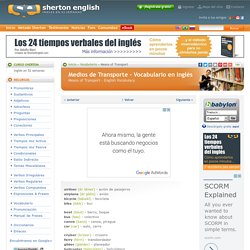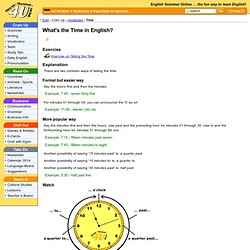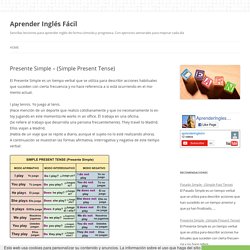

Medios de Transporte - Vocabulario en Inglés - Means of Transport. Airliner (ér láiner) - avión de pasajerosairplane (ér pléin) - aviónbicycle (báisikl) - bicicletabike (báik) - bici.

Means of Transportation. TRANSPORT. Means of Transport - English Language. Transport. Times. English Vocabulary - Telling Time. What time is it? The time in English. What's the Time in English. Exercise Exercise on Telling the Time Explanation There are two common ways of telling the time.

Formal but easier way Say the hours first and then the minutes. Example: 7:45 - seven forty-five For minutes 01 through 09, you can pronounce the '0' as oh. Example: 11:06 - eleven (oh) six More popular way Say the minutes first and then the hours. Example: 7.15 - fifteen minutes past seven Example: 7.45 - fifteen minutes to eight Another possibility of saying '15 minutes past' is: a quarter past Another possibility of saying '15 minutes to' is: a quarter to Another possibility of saying '30 minutes past' is: half past Example: 5:30 - half past five Watch Note Use o'clock only at the full hour. Example: 7:00 - seven o'clock (but 7:10 - ten past seven) In English ordinary speech, the twelve-hour clock is used.Timetables usually use the twenty-four-hour clock. Beispiel: 17:20 - twenty past five For times around midnight or midday you can use the expressions midnight or midday / noon instead of the number 12.
Morning-routine. Evening-routine. Ingles las rutinas diarias. Daily Routines. Daily routines (las rutinas) Good-Night-Routine. Simple Present Tense. Simple Present Tense. Presente Simple – (Simple Present Tense) El Presente Simple es un tiempo verbal que se utiliza para describir acciones habituales que suceden con cierta frecuencia y no hace referencia a si está ocurriendo en el momento actual.

I play tennis. Yo juego al tenis. (Hace mención de un deporte que realizo cotidianamente y que no necesariamente lo estoy jugando en este momento).He works in an office. Él trabaja en una oficina. (Se refiere al trabajo que desarrolla una persona frecuentemente). A continuación se muestran las formas afirmativa, interrogativa y negativa de este tiempo verbal: En el cuadro superior se ha tomado como ejemplo el verbo PLAY (jugar). He eats vegetables. En el modo interrogativo y negativo se utiliza el auxiliar DO, aunque en la 3º persona del singular se coloca como auxiliar DOES y se le quita la “S” al verbo. Existen algunos casos particulares como por ejemplo, si el verbo empleado termina en “SS”, “SH”, “CH”, “O” y “X” al formar la 3º persona del singular en la forma afirmativa se le agrega “ES”. Present Simple Tense. PresentSimple.